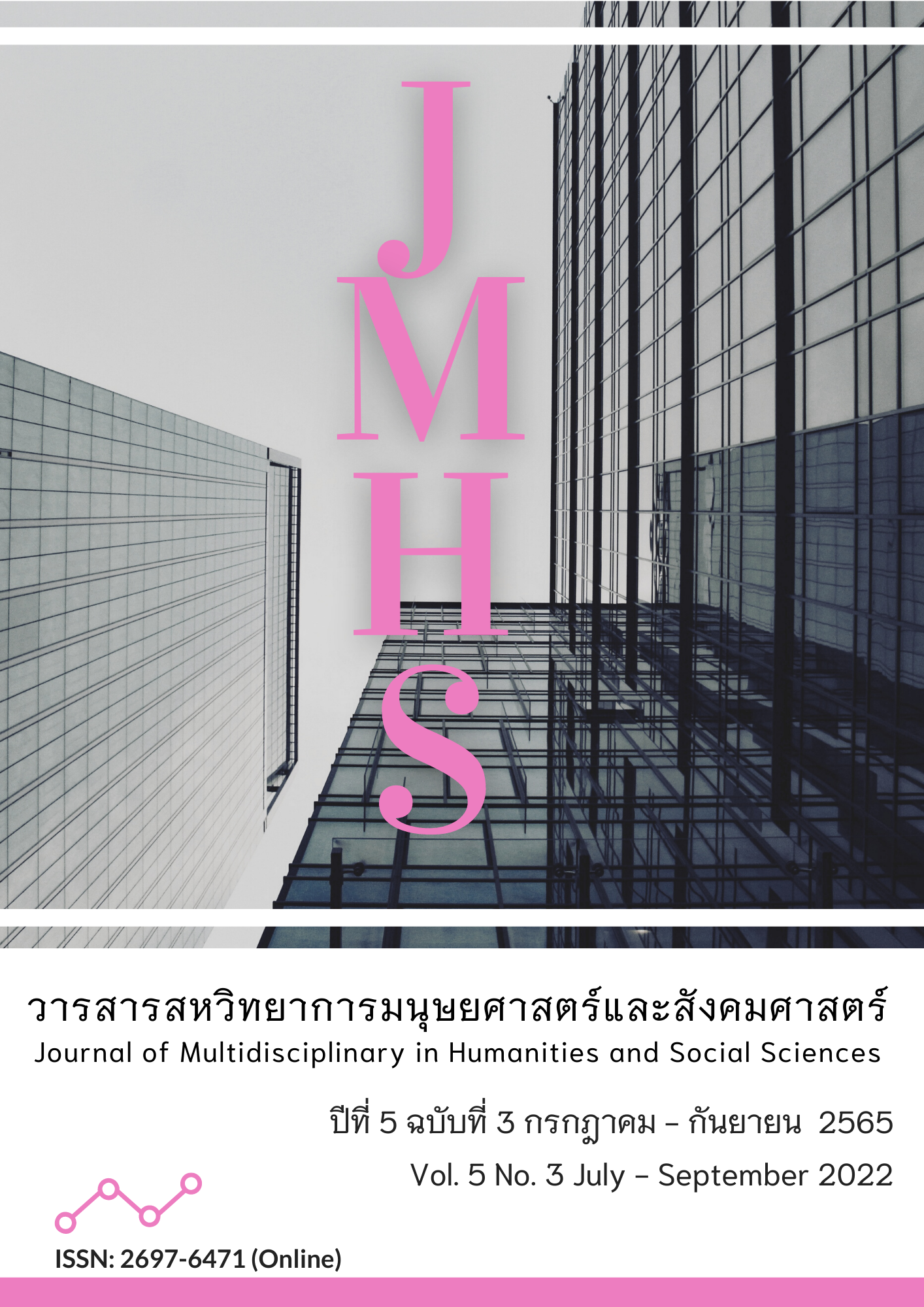The Causal Factors Influencing of Purchase Decision Books on Thaibookfair Website in Bangkok and its Vicinity
Main Article Content
Abstract
The objectives of this article were 1) to develop and validate the consistency of purchase decisions for books on the Thaibookfair website in Bangkok and its vicinity and 2) to study causal factors influencing purchase decisions for books on the Thaibookfair website in Bangkok and its vicinity. This study was quantitative research. The sample consisted of people who have bought books on the Thaibookfair website and live in Bangkok and its vicinity of 400 people. The tools used in the research were online questionnaires. The statistics used in the data analysis were frequency, percentage, and structural equation models.
The results of this research were the development of causal relationship models, consisting of five components: 1) brand image, 2) security, 3) perceived risk, 4) trust, and 5) purchase decision, and the model was consistent with the empirical data to a great extent. The statistics showed that the Chi-square statistics goodness fit test (2) = 321.63, degrees of freedom (df) = 233, CMIN/df = 1.38, GFI = 0.94, AGFI = 0.92, SRMR = 0.05, RMSEA = 0.03. The final predictive coefficient was 0.53, indicating that the model variables can explain 53% of the variance in book purchase decisions on the Thaibookfair Website. It was discovered that the one factor that had the greatest influence and direct effect on purchase decisions was trust. The results of this research, selling books business on the website should pay attention to the trust factor, to make buyers trust the quality of the books sold on the website.
Article Details

This work is licensed under a Creative Commons Attribution-NonCommercial-NoDerivatives 4.0 International License.
Views and opinions appearing in the Journal it is the responsibility of the author of the article, and does not constitute the view and responsibility of the editorial team.
References
กริช แรงสูงเนิน. (2554). การวิเคราะห์ปัจจัยด้วย SPSS และ AMOS เพื่อการวิจัย. กรุงเทพฯ: ซีเอ็ดยูเคชั่น.
ณฐอร สมพงษ์. (2564, 26 กรกฎาคม). ตามไปดู “ร้านหนังสือ” ยุคโควิด แม้ลุยขายออนไลน์แต่ยอดไม่ดีเท่าหน้าร้าน. สืบค้นเมื่อ 29 พฤศจิกายน 2564, จาก https://www.thairath.co.th/business/feature/2147670
ณรงค์เวตย์ เรืองจวง. (2561). แนวทางการพัฒนาขีดความสามารถบุคลากร ด้านไซเบอร์ของกองทัพอากาศ. วารสารรัฏฐาภิรักษ์, 60(3), 22-33.
ทิวาวรรณ ศรีสวัสดิ์. (2559). โมเดลความสัมพันธ์เชิงสาเหตุของการเกี่ยวข้องกับสถานการณ์และความไว้วางใจที่มีต่อการตั้งใจเลือกซื้อจากร้านค้าออนไลน์ของผู้บริโภคชาวไทย. วารสารวิทยาลัยพาณิชยศาสตร์บูรพาปริทัศน์, 11(2), 31-46.
นงลักษณ์ วิรัชชัย. (2542). โมเดลลิสเรล: สถิติวิเคราะห์สำหรับการวิจัย. (พิมพ์ครั้งที่ 3). กรุงเทพฯ: โรงพิมพ์แห่งจุฬาลงกรณ์มหาวิทยาลัย.
นพดล นพรัตน์. (2564, 1 เมษายน). การสร้างความไว้วางใจ. สืบค้นเมื่อ 24 เมษายน 2565, จากhttps://www.noppol.net/uncategorized/การสร้างความไว้วางใจ-trust
นภสินธุ์ สุวรรณธาร และ บดินทร์ รัศมีเทศ. (2564). ปัจจัยที่ส่งผลต่อการตัดสินใจเลือกซื้อกองทุนออนไลน์ผ่านแอปพลิเคชันในเขตกรุงเทพมหานคร. วารสารศิลปการจัดการ, 5(3), 586-598.
นัฏฐิกานต์ อัศวมงคลพันธุ์. (2561). การตลาดผ่านเครือข่ายสังคมออนไลน์ ที่ส่งผลต่อการตัดสินใจซื้อเครื่องสำอางออร์แกนิกของผู้บริโภคในเขตกรุงเทพมหานคร. วารสารวิทยาลัยดุสิตธานี, 12(3), 397-413.
ปราณ สุวรรณทัต. (2563, 8 เมษายน). โควิด-19 ระบาด ทำยอดขายงานสัปดาห์หนังสือออนไลน์ครั้งแรกรายได้ทะลุ 36 ล้านบาท. สืบค้นเมื่อ 29 พฤศจิกายน 2564, จาก https://brandinside.asia/thai-book-fair-online-first-time/
ปัณณทัต กาญจนะวสิต. (2560). โลกยุค 4.0. สืบค้นเมื่อ 29 พฤศจิกายน 2564, จาก http://www.dsdw2016.dsdw.go.th/doc_pr/ndc_2560-2561/PDF/m8455/8455โลกยุค% 204.0.pdf
ปาณิศา ศรีละมัย. (2561). อิทธิพลของความไว้วางใจที่มีต่อการตัดสินใจซื้อผลิตภัณฑ์ทำความสะอาดผิวหน้าที่มีส่วนผสมจากธรรมชาติผ่านร้านค้าปลีก. วารสารสหวิทยาการวิจัย: ฉบับบัณฑิต ศึกษา, 7(2), 1-10.
ปารมี รอดกลิ่น. (2562). ความไว้วางใจต่อการตัดสินใจซื้ออัญมณีและเครื่องประดับบนตลาดออนไลน์ผ่านช่องทางการถ่ายทอดสดเฟซบุ๊กไลฟ์. วารสารเศรษฐศาสตร์และบริหารธุรกิจ มหาวิทยาลัยทักษิณ, 11(2), 21-30.
พิมพ์นารา หิรัญกสิ และ ชุติภา คลังจตุรเวทย์. (2564, 30 กันยายน). วิจัยกรุงศรี ฉายภาพ “Social Commerce คลื่นลูกใหม่ของพาณิชย์อิเล็กทรอนิกส์”. สืบค้นเมื่อ 29 พฤศจิกายน 2564, จาก https://thaipublica.org/2021/09/krungsri-research-on-social-commerce/
มาร์เก็ตเธียร์. (18 ธันวาคม 2546). Perceived Risk. สืบค้นเมื่อ 29 พฤศจิกายน 2564, จาก http://www.marketeer.co.th/inside_detail.php?inside_id=2209
รัตนา อัตภูมิสุวรรณ์ และ สุภมาส อังศุโชติ. (2560). กระบวนการตัดสินใจซื้อและการกำหนดปัจจัยการบริโภคที่มีอิทธิพลต่อพฤติกรรมการบริโภคแบบยั่งยืนของบุคลากรในสถาบันอุดมศึกษา. วารสารวิจัยและพัฒนา มจธ., 40(1), 3-16.
วรวีร์ เธียรธนเกียรติ. (2560). การรับรู้ประโยชน์ของการช้อปปิ้งออนไลน์ การรับรู้ความเสี่ยง ความไว้วางใจและการตัดสินใจซื้อสินค้าอิเล็กทรอนิกส์ผ่านเว็บไซต์พาณิชย์อิเล็กทรอนิกส์. วารสารการสื่อสารและการจัดการ นิด้า, 3(1), 1-15.
วิทยาพล ธนวิศาลขจร และ คณะ. (2560). ภาพลักษณ์ตรา สินค้าที่มีอิทธิพลต่อการตัดสินใจซื้ออาหารแช่แข็งของผู้บริโภคในกรุงเทพมหานคร. วารสารการวิจัยการบริหารการพัฒนา, 8(1), 18-25.
ศิริลักษณ์ โรจนกิจอำนวย. (2561). การรับรู้ความเสี่ยงและความไว้วางใจที่ส่งผลต่อการซื้อผ่านพาณิชย์อิเล็กทรอนิกส์ข้ามพรมแดน. จุฬาลงกรณ์ธุรกิจปริทัศน์, 40(157), 79-99.
อานุมาต มะหมัด และ พีรภาว์ ทวีสุข. ( 2561). ภาพลักษณ์ตราสินค้าที่มีอิทธิพลต่อกระบวนการ ตัดสินใจซื้อผลิตภัณฑ์อาหารแปรรูปประเภทไส้กรอก ในร้านสะดวกซื้อ A ในกรุงเทพมหานคร. วารสารสุทธิปริทัศน์, 32(103), 131-145.
Hair, J. F., Black, W. C., Babin, B. J., & Anderson, R. E. (2010). Multivariate data analysis. (7th ed.). New York: Pearson.
Kline, R. B. (2011). Principles and Practice of Structural Equation Modeling. (3rd ed.). New York: The Guildford Press.
Lassoued, R., & Hobbs, J. E. (2015). Consumer Confidence in Credence Attributes: The Role of Brand Trust. Food Policy, 52(1), 99–107.
Mahliza, F. (2020). Consumer Trust in Online Purchase Decision. EPRA International Journal of Multidisciplinary Research, 6(2), 142-149.
Sharma, K., Ow-jariyapithak, D., Dasri, P., Van Brecht, D., & Sahakijpicharn, D. (2021). Impact of Corporate Governance on Firm Efficiency: A Study of Thai Banking Companies. International Journal of Multidisciplinary in Management and Tourism, 5(2), 66–86. https://doi.org/10.14456/ijmmt.2021.8
Whitman, E. M., & Mattord, J. H. (2005). Principles of Information Security. (2nd ed.). New York: Kennesaw State University.
Wongmonta, S. (2021). Post-COVID 19 Tourism Recovery and Resilience: Thailand Context. International Journal of Multidisciplinary in Management and Tourism, 5(2), 137–148. https://doi.org/10.14456/ijmmt.2021.12
Zhou, T., Lu, Y., & Wang, B. (2010). Integrating TTF and UTAUT to Explain Mobile Banking User Adoption. Computers in Human Behavior, 26(4), 760-767.


